|
HOME: www.hiltonpond.org |
|||
THIS WEEK at HILTON POND Subscribe for free to our award-winning nature newsletter (Back to Preceding Week; on to Next Week) |
--ONE BONUS SLOT LEFT! -- Come be part of a real |
FALL MIGRATION 2017: A variety of happenings--from travel to illness to bereavement to other tasks and calamities (such as a computer meltdown)--significantly competed for our time and attention during Autumn 2017 at Hilton Pond Center. As a result, we were unable to produce our usual timely account of natural history occurrences during October. We did manage to take a few photos, however, so for the sake of continuity we offer them now with comments--mostly about fall bird migration. Because research did continue on a limited basis at the Center in October, we also include below a tally of all birds banded or recaptured during the period. We look forward to providing more frequent reports during 2018. Until then . . . Happy Nature Watching! All text, maps, charts & photos © Hilton Pond Center
All text, maps, charts & photos © Hilton Pond Center A Wood Thrush (above) captured on the evening of 6 October 2017 was our 66,665th individual banded at Hilton Pond Center since 1982. When we posted to the Center's FaceBook page that we were a little apprehensive about what the 66,666th bird might be, we got some interesting and diabolical predictions: Horned Lark . . . Great Horned Owl . . . Horned Grebe . . . or even (improbably) a Ulama, the Devil Bird of Sri Lanka (known for its blood-curdling nocturnal call). In pursuit of that next notorious bird we went out shortly after dawn the following morning to deploy mist nets and to prime several hummingbird traps. Observers in more northerly locales had been reporting excellent migration fallout, so we hoped some of these birds had moved through the Carolina Piedmont overnight. We also hoped to snare any late Ruby-throated Hummingbirds still around. Alas, light drizzle set in at mid-morning and continued throughout the day, likely causing many birds to sit tight. Net check after net check revealed no new captures, and we were concerned the banding total for the day might be zero.
All text, maps, charts & photos © Hilton Pond Center Finally, at 5:15 p.m. we encountered a hatch-year (immature) female Northern Cardinal (above) in a net, and she became the elusive #66,666. It turns out this was entirely appropriate, since she bit like Hades as we tried to take her photo and had to settle for a shot that showed a bite-controlling finger instead of just her stately profile. Note the dark color of her immature bill that will gradually turn bright orange as she lays down carotene pigment. Another sign of her youthfulness is a sparsely feathered, wispy crest that will eventually fill out; her overall plumage will become more orange than brown. In case you're wondering, the only other bird banded that day was our first Gray-cheeked Thrush of the year. Now that 66,666 has been reached, this thrush put us on the way toward our next goal of 67,000 birds banded at Hilton Pond since 1982. That milestone likely won't be reached unless and until winter finches start to arrive along about November. All text, maps, charts & photos © Hilton Pond Center
All text, maps, charts & photos © Hilton Pond Center On the morning of 7 October 2017--prior to a light drizzle that fell most of the day--Rootless Duckweed (above) floating on Hilton Pond swirled mysteriously into a pinwheel shape that looked for all the world like the aerial view of a Northern Hemisphere hurricane--except it rotated clockwise. You can see the Center's white digital weather station on a pole just below the eye of the "storm." The swirl disappeared later in the day as the wind picked up and pushed the duckweed to one end. We have no idea what might have caused this phenomenon and welcome your suggestions. Just send an e-mail to INFO.(NOTE: The pond's overflow pipe is at the far side near the dam, so the swirl wasn't drain-related.) All text, maps, charts & photos © Hilton Pond Center Fall migration was uncharacteristically slow in September and October 2017 at Hilton Pond Center, with few passerines observed passing through. We suspect our strange weather may have had at least some effect--two hurricanes come to mind, alomg with unseasonably (unreasonably?) warm temperatures the first half of October. We deployed eight mist nets early on the morning of 12 October and caught nothing until mid-afternoon--not even any of those pesky resident chickadees or titmice that usually keep us busy. Things finally picked up about 3 p.m. and in short order we netted THREE immature Bay-breasted Warblers. This was rather startling because we'd only banded 13 of them in the preceding 35 years at the Center!
All text, maps, charts & photos © Hilton Pond Center It was good to capture those three fat-laden Wood Warblers on their way to Cuba or perhaps northwestern South America, but for sheer eye-pleasingness the bird of the day was a long-named hatch-year male Black-throated Blue Warbler (BTBW; see photo above). This species is a lot more common locally than Bay-breasted Warblers, with 190 banded since 1982. Unlike many parulids, a young male BTBW acquires adult-like plumage his first summer--although some wing feathers and his back are typically tinged with green. The white wing patch may also be less prominent in young males. Black-throated Blue Warblers breed up the spine of the Appalachians and throughout the northeastern U.S. and southeastern Canada. (South Carolina has a smattering of nesting records for the extreme northwestern counties, although the species nests more commonly in western North Carolina.) Across their range BTBW breed primarily in hardwood and mixed coniferous-deciduous woodlands with thick understory, often on steep slopes. They winter primarily in the Caribbean, eastern Costa Rica, and Panama. Like most warblers, BTBW consume huge numbers of caterpillars and other small invertebrates; occasionally they eat small berries. All text, maps, charts & photos © Hilton Pond Center
All text, maps, charts & photos © Hilton Pond Center On 13 October we again got up early to deploy mist nets at Hilton Pond Center and--just as the day before--there was no bird action until mid-afternoon. We suspect what was happening was that Neotropical migrant songbirds were flying all night, arriving exhausted at the Center before dawn, and then settling down for several hours of rest before rousing to forage for a few hours before nightfall. The birds we captured seemed to be doing pretty well since all were bulging with high-energy yellow fat needed for a long migratory trek. Among yesterday's birds were several parulids, including one of those mis-named "confusing fall warblers" whose mug shot is included above. Based on measurements we suspected it was a female, although young males and females look pretty much alike in this species.
All text, maps, charts & photos © Hilton Pond Center A view of the underside of the tail was more enlightening, with a short and bright yellow crissum (i.e., undertail coverts, above). Note also large white spots on the outer two pairs of rectrices (tail feathers).
All text, maps, charts & photos © Hilton Pond Center A lateral look (above) at the entire mid-winter immature bird shows no signs of an adult Palm Warbler's chestnut cap. However, the rump does reveal a yellow patch that sometimes causes folks in autumn to confuse this species with immature Yellow-rumped Warblers.
All text, maps, charts & photos © Hilton Pond Center Birding experts would call the bird we caught this week a "Western Palm Warbler," as opposed to a Yellow Palm Warbler (above)--a race that sports considerably more of that hue in its plumage. Oddly, it is Western Palm Warblers that seem to show up most frequently in autumn at Hilton Pond Center and elsewhere in the eastern U.S. All text, maps, charts & photos © Hilton Pond Center
All text, maps, charts & photos © Hilton Pond Center Much-needed overnight rain at Hilton Pond Center continued through early afternoon on 16 October and prevented unfurling any mist nets, bringing an end to our string of fall days banding Neotropical migrant warblers, thrushes, etc. We considered opening our nets the afternoon of the 16th but got thwarted because someone ran over a Striped Skunk on the road directly in front of the Center's old farmhouse. The stench was so overpowering we couldn't even go outside without tears coming to our eyes and becoming overwhelmed by nausea. Some skunks permeate worse than others, and this dead one--nearly all-white--was a world-class stinker! Fortunately, our photo above of a live individual is NOT scratch n' sniff! Two words: P and U. All text, maps, charts & photos © Hilton Pond Center With a phenomenal fall bird migration revealed by radar stations across the eastern U.S., we were up before dawn on 17 October in cool temperatures to unfurl a dozen mist nets at Hilton Pond Center. Once again it was very slow going and an anticipated influx of birds never occurred locally. A Swainson's Thrush hit a net at 9:35 a.m., then nothing until an American Goldfinch at 12:15 p.m. As the afternoon progressed, nets snared another goldfinch, a Yellow-rumped Warbler, a Northern Cardinal, a Blue Jay, and a Red-bellied Woodpecker--slow going, indeed. Because none of these birds was particularly unusual we had decided to post an image of the jay because it nicely illustrated how to conclude that particular individual was immature. That plan changed just at dusk when we spooked a tiny dark brown bird into a net near one of the Center's gurgling water features.
All text, maps, charts & photos © Hilton Pond Center And we DO mean tiny--perhaps the smallest non-hummingbird we ever band at Hilton Pond. Oh, kinglets and gnatcatchers might rival this species for minuteness but they have relatively extended tails, and this bird's rectrices were anything but long. Just knowing it was a tiny dark brown bird with very short tail is about all you need to identify the species, especially if we mention the wings and tail and flanks were conspicuously marked with fine barring. If you're thinking "Winter Wren," you'd be right! We were excited to have this bird in-hand because it was only the 13th of its species captured at the Center in 36 years! In fact, most Carolina Piedmont birders would say one Winter Wren sighted on a midwinter field trip makes it a good day. It's not that the species is so rare, but it can be rather hard to find. Small and secretive, it often hangs around in dense thickets through which a small stream flows. We suspect this bird was attracted by the sound of falling water in the water feature--thanks to the action of our trusty recirculating pump. As its name suggests, the Winter Wren occurs in the South only during cold months. It breeds up the Appalachians into the northeastern U.S. and across much of Canada. A mature male's surprisingly loud courtship song is among the longest and most complex in all of birddom. It was almost dark by the time we extricated, measured, and banded today's Winter Wren, so we had time for only a quick photo before letting the bird adjust to twilight and be on its way. The image above was as good as we could manage, but we share it here because it shows the Winter Wren's signature posture with bobtail sticking nearly straight up in the air. (We also included more fingers in the photo than usual--just to give a real indication of just how tiny this bird really is. Incidentally, we recaptured the bird a couple more times in following days, indicating it was just fine after banding.) All text, maps, charts & photos © Hilton Pond Center It was yet another slow day for banding on 18 October at Hilton Pond Center. It didn't help there was a cacophony of nearby lawn equipment for much of the morning; furthermore, some birds were probably hunkered down, TRYING to sleep and waiting for the temperature to rise above our chilly overnight autumn low of 42.5°F. The day's tally included one each of Pine Warbler, Wood Thrush, Swainson's Thrush, House Finch, Eastern Bluebird, and a migratory woodpecker. Migratory woodpecker, you say? Well, in the Carolina Upper Piedmont that means one of two species and doesn't include Downy, Hairy, Pileated, Red-bellied, and Red-headed Woodpeckers--all of which may disperse in autumn but don't really migrate. (NOTE: Red-cockaded Woodpeckers occasionally stray into the Lower Piedmont, but they're pretty much birds of the Sandhills and Coastal Plain.)
All text, maps, charts & photos © Hilton Pond Center So what two picids (from Picidae, the Woodpecker Family) does that leave us? One is the Northern (formerly Yellow-shafted) Flicker, whose northern populations DO migrate. (Most Carolinas flickers are likely year-round residents.) The other is Yellow-bellied Sapsucker, a species that nests primarily in the Atlantic Coastal and New England states and most of Canada--although there are numerous breeding records at higher elevations in North Carolina's mountains. The bird we banded on the 18th was a female Yellow-bellied Sapsucker (above), a species we always say is "twice named wrongly."
Flickers and sapsuckers both have foraging strategies that mean they can't really hang out where it gets too cold. Sap doesn't run well in sub-freezing temperatures, and if the substrate is covered by snow a ground-feeding flicker can't get at ants that comprise a large part of its diet. Thus, it makes sense these two species would migrate while the other wood-pecking woodpeckers can get at grubs from dead snags all winter long. [NOTE: We have reports that backyard suet feeders and bark butter may entice flickers to overwinter further north than they did historically.] If you're wondering why we said the bird in our top photo is a FEMALE Yellow-bellied Sapsucker, the secret is in the gorget. Male sapsuckers have red chins, while a female's is plain. Hmmm. Since Ruby-throated Hummingbirds are so-named because of the male, perhaps an even better epithet for today's woodpecker would be "Garnet-throated Saplapper.") P.S. The day's capture was just our 46th migratory sapsucker banded since 1982 at Hilton Pond Center. Compare that to 225 Downy Woodpeckers that breed locally. P.P.S. Amazingly, we have seen Yellow-Bellied Sapsuckers as far south as our hummingbird research sites in Guanacaste Province, Costa Rica! All text, maps, charts & photos © Hilton Pond Center Don't forget to scroll down for Nature Notes & Photos, 
Checks can be sent to Hilton Pond Center at: All contributions are tax-deductible on your |
|---|
|
"This Week at Hilton Pond" is written and photographed by Bill Hilton Jr., executive director of Hilton Pond Center for Piedmont Natural History
|
|
|
Please refer "This Week at Hilton Pond" to others by clicking on this button: |
Comments or questions about this week's installment? Send an E-mail to INFO. (Be sure to scroll down for a tally of birds banded/recaptured during the period, plus other nature notes.) |

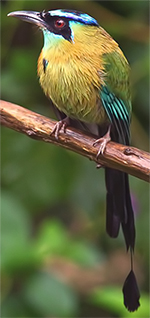 STILL TIME TO SIGN UP
STILL TIME TO SIGN UP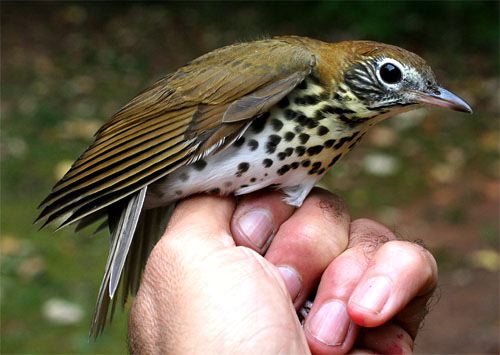
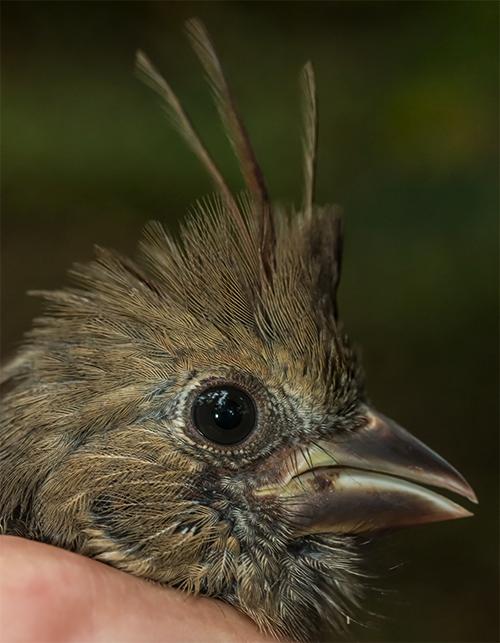
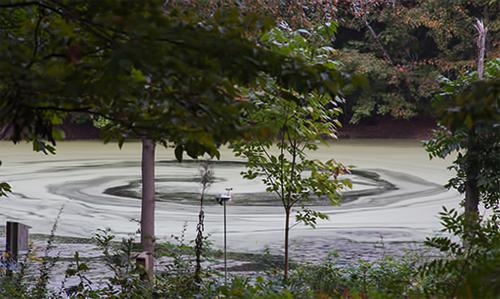
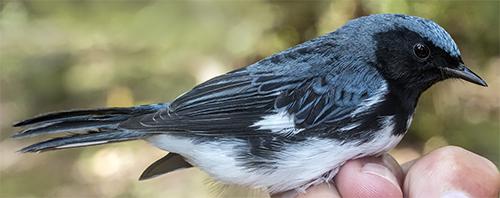
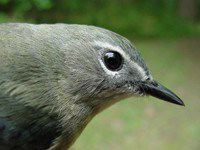
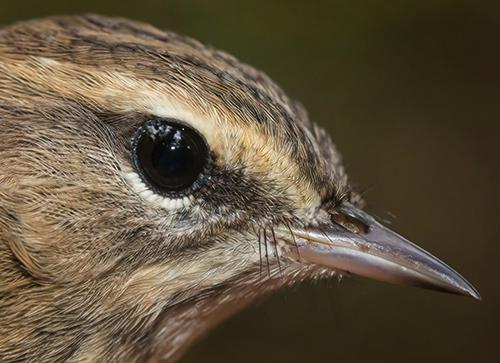
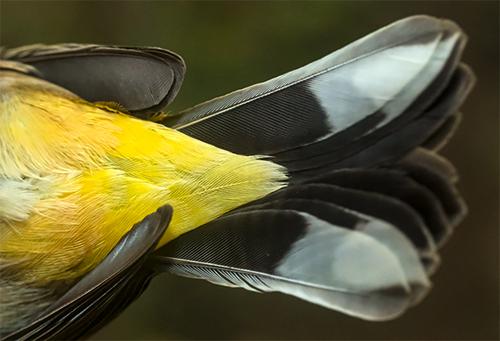
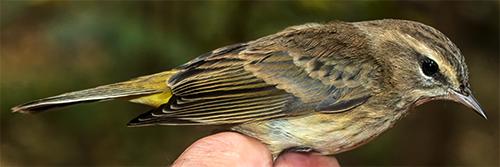
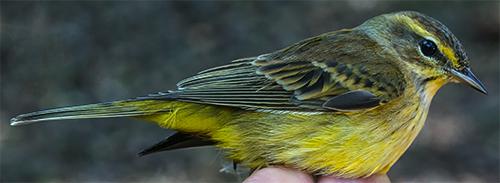
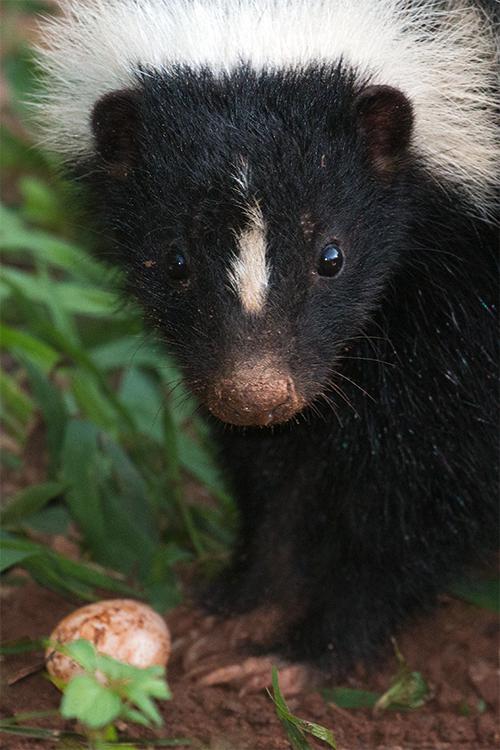
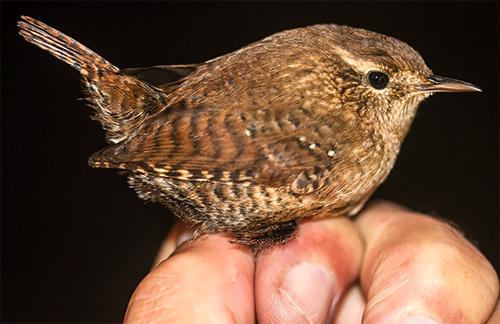
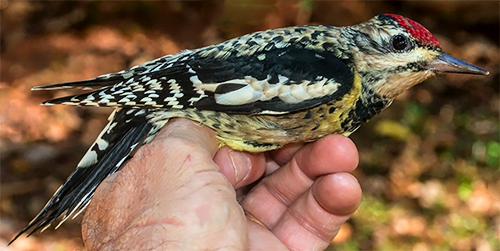
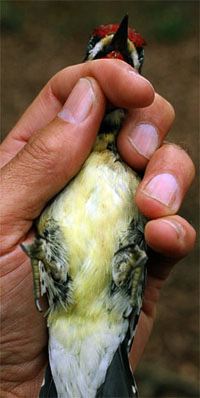 First of all, sapsuckers do not suck. Like hummingbirds, they mostly use their tongues to LAP up sweet liquids. On top of that, you seldom get to see a sapsucker's yellow belly
First of all, sapsuckers do not suck. Like hummingbirds, they mostly use their tongues to LAP up sweet liquids. On top of that, you seldom get to see a sapsucker's yellow belly 







 Please report your
Please report your